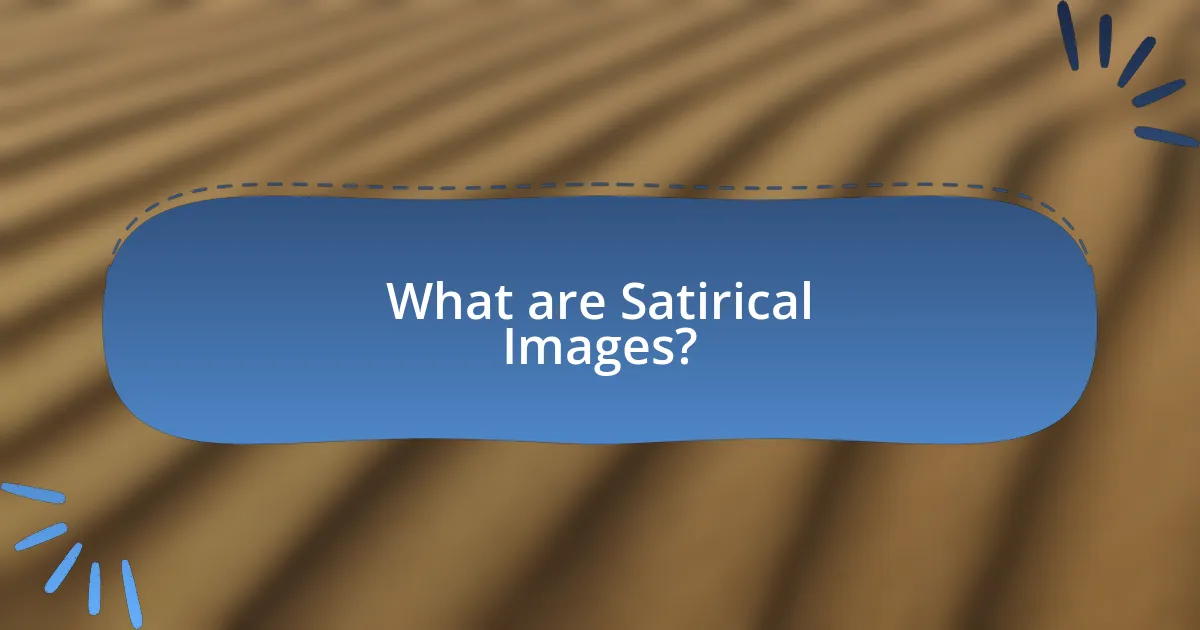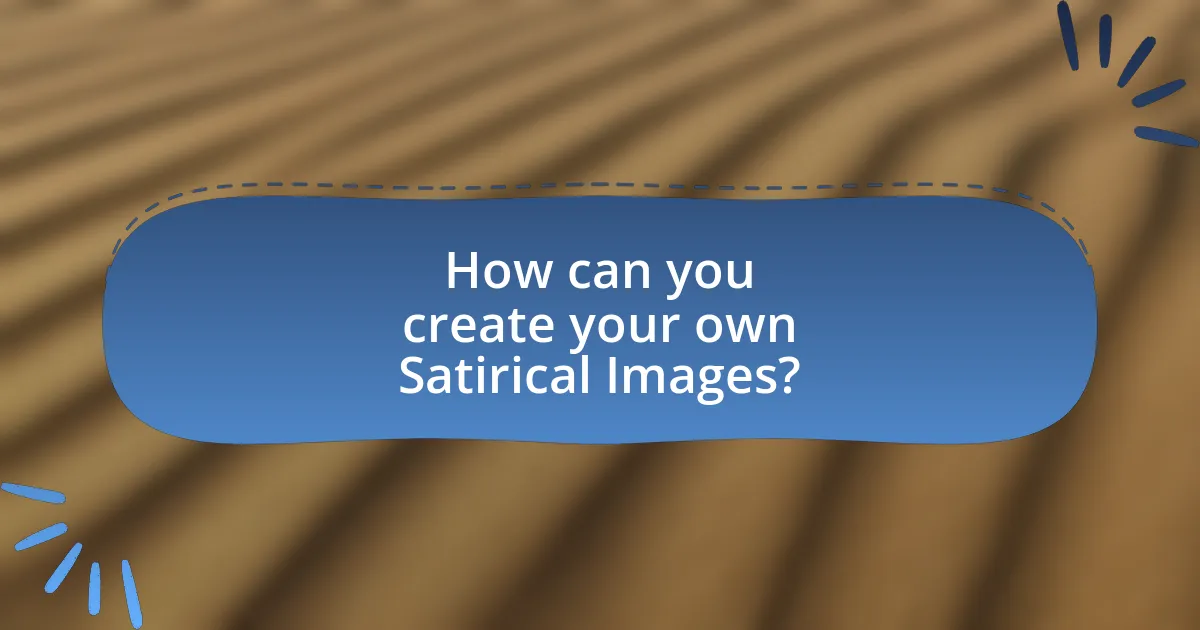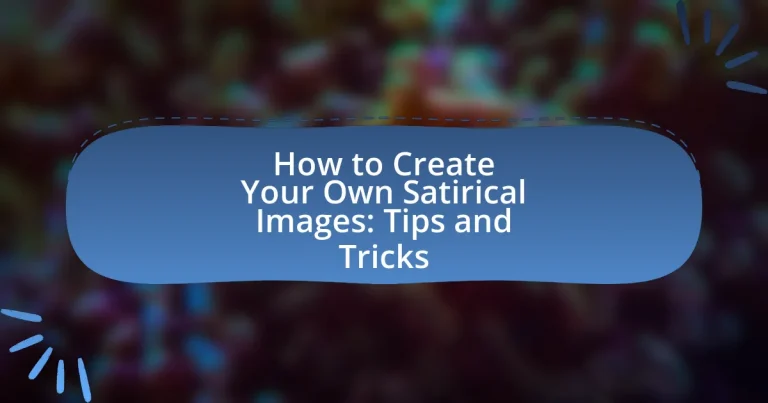Satirical images are visual representations that utilize humor, irony, or exaggeration to critique societal norms, politics, or cultural issues. This article provides a comprehensive guide on creating effective satirical images, detailing techniques such as exaggeration, juxtaposition, and parody. It also discusses the importance of cultural references, tools for image creation, and best practices for sharing satirical content on social media. Additionally, the article highlights common mistakes to avoid and strategies to enhance the visual impact and reach of satirical images, ensuring they effectively engage and provoke thought among audiences.

What are Satirical Images?
Satirical images are visual representations that use humor, irony, or exaggeration to criticize or mock individuals, institutions, or societal norms. These images often convey a deeper message about political, social, or cultural issues, making them a powerful tool for commentary. For example, political cartoons frequently employ satire to highlight the absurdities of government actions or public figures, effectively engaging audiences in critical discourse.
How do Satirical Images convey messages?
Satirical images convey messages by using humor, exaggeration, and irony to critique societal norms, politics, or cultural issues. These images often juxtapose familiar symbols or scenarios with absurd or exaggerated elements, prompting viewers to reflect on the underlying message. For instance, political cartoons frequently depict public figures in a distorted manner to highlight their flaws or controversial actions, effectively engaging the audience in critical thinking about current events. This method of visual communication allows for complex ideas to be expressed succinctly, making them accessible and thought-provoking for a wide audience.
What techniques are commonly used in Satirical Images?
Common techniques used in satirical images include exaggeration, juxtaposition, parody, and symbolism. Exaggeration amplifies certain features or characteristics to highlight absurdities, while juxtaposition places contrasting elements side by side to create a striking effect that underscores the satire. Parody mimics the style of a particular genre or work to critique it, and symbolism uses visual metaphors to convey deeper meanings or critiques of societal issues. These techniques effectively engage viewers and provoke thought, making the satire impactful and memorable.
How do cultural references enhance Satirical Images?
Cultural references enhance satirical images by providing context that resonates with the audience, making the satire more relatable and impactful. These references draw on shared knowledge, such as popular media, historical events, or societal norms, which allows viewers to quickly grasp the underlying message or critique. For instance, a satirical image that incorporates a well-known political figure or a viral meme can evoke immediate recognition, amplifying the humor and critique embedded in the artwork. This effectiveness is supported by studies indicating that humor often relies on shared cultural understanding, as seen in the work of researchers like Peter McGraw and his Benign Violation Theory, which suggests that humor arises when a violation of social norms is perceived as benign due to cultural context.
Why are Satirical Images important in modern media?
Satirical images are important in modern media because they serve as powerful tools for social commentary and critique. These images can effectively convey complex ideas and provoke thought by using humor and exaggeration to highlight societal issues, political events, or cultural norms. For instance, studies have shown that satirical content can increase public engagement and awareness, as seen in the popularity of platforms like social media where such images are widely shared. This engagement is crucial in an era where traditional news consumption is declining, making satirical images a vital component of contemporary discourse.
What role do Satirical Images play in social commentary?
Satirical images serve as powerful tools for social commentary by using humor and exaggeration to critique societal norms, political issues, and cultural phenomena. These images often simplify complex topics, making them accessible and engaging for a broader audience. For instance, political cartoons have historically influenced public opinion by highlighting the absurdities of political figures and policies, as seen in the works of artists like Thomas Nast in the 19th century, who used satire to expose corruption in politics. This effectiveness is rooted in the ability of satirical images to provoke thought and discussion, encouraging viewers to reflect on the underlying issues being addressed.
How can Satirical Images influence public opinion?
Satirical images can significantly influence public opinion by simplifying complex issues and provoking emotional responses. These images often use humor and exaggeration to critique societal norms, political figures, or current events, making them more relatable and engaging for the audience. Research indicates that satirical content can enhance awareness and understanding of political issues, as seen in studies showing that exposure to satirical news increases political knowledge among viewers. For example, a study published in the journal “Political Communication” found that individuals who consumed satirical content were more likely to discuss political topics and engage in civic activities. This demonstrates that satirical images not only entertain but also serve as powerful tools for shaping public discourse and opinion.

How can you create your own Satirical Images?
To create your own satirical images, start by identifying a current event or social issue that you want to comment on. Next, use image editing software, such as Adobe Photoshop or free alternatives like GIMP, to manipulate existing images or create new visuals that convey your message humorously or ironically. Incorporate text, symbols, or caricatures to enhance the satire. Research shows that satire can effectively provoke thought and discussion, as evidenced by its historical use in political cartoons, which often highlight societal flaws through humor.
What tools and software are best for creating Satirical Images?
The best tools and software for creating satirical images include Adobe Photoshop, GIMP, and Canva. Adobe Photoshop is widely recognized for its advanced editing capabilities, allowing users to manipulate images extensively, which is essential for creating impactful satire. GIMP, an open-source alternative, offers similar features without the cost, making it accessible for those on a budget. Canva provides user-friendly templates and design elements that facilitate quick creation of satirical graphics, appealing to those who may lack advanced design skills. These tools are validated by their popularity among graphic designers and content creators, who utilize them for their versatility and effectiveness in producing engaging visual satire.
How do different software options compare for beginners?
Different software options for beginners in creating satirical images vary significantly in terms of usability, features, and learning curve. For instance, Adobe Photoshop offers extensive tools for image manipulation but can be overwhelming for newcomers due to its complexity. In contrast, Canva provides a user-friendly interface with drag-and-drop functionality, making it easier for beginners to create visually appealing images without prior design experience. GIMP, while free and powerful, has a steeper learning curve similar to Photoshop, which may deter some beginners. According to a survey by Creative Bloq, 70% of beginners prefer Canva for its simplicity and accessibility, highlighting its effectiveness for those new to image creation.
What features should you look for in image editing tools?
When selecting image editing tools, look for features such as user-friendly interfaces, a variety of editing options (like cropping, resizing, and color adjustments), and advanced capabilities (such as layers, filters, and effects). User-friendly interfaces ensure accessibility for beginners, while a range of editing options allows for basic modifications essential for creating satirical images. Advanced capabilities, including layers and filters, enable more complex edits, which are crucial for achieving the desired satirical effect. Tools like Adobe Photoshop and GIMP exemplify these features, providing extensive functionalities that cater to both novice and experienced users.
What steps should you follow to create effective Satirical Images?
To create effective satirical images, begin by identifying a relevant social or political issue that resonates with your audience. This step is crucial as it ensures the image addresses a topic that elicits strong reactions or thoughts. Next, develop a clear and concise message that encapsulates your viewpoint on the issue, as clarity enhances the impact of satire. Following this, choose visual elements that exaggerate or distort reality to emphasize your message; for instance, using caricatures or absurd scenarios can effectively highlight the absurdity of the subject matter. Finally, consider the context in which the image will be shared, as timing and platform can significantly influence its reception and effectiveness. These steps are supported by the understanding that satire relies on both humor and critique to provoke thought and discussion among viewers.
How do you brainstorm ideas for Satirical Images?
To brainstorm ideas for satirical images, start by identifying current social, political, or cultural issues that resonate with audiences. Engaging with trending topics allows for relevant and impactful satire. For instance, analyzing news headlines or popular memes can inspire visual concepts that critique or humorously reflect these issues. Research shows that satire often thrives on exaggeration and irony, which can be effectively conveyed through imagery that juxtaposes familiar symbols with unexpected elements. This method not only captures attention but also encourages viewers to think critically about the subject matter.
What is the process of sketching and planning your image?
The process of sketching and planning your image involves several key steps that ensure clarity and effectiveness in visual communication. First, define the concept or message you want to convey through your image, as this will guide your creative direction. Next, create rough sketches to explore different compositions and layouts, allowing for experimentation with elements such as perspective, scale, and focal points. After selecting a preferred sketch, refine it by adding details and considering color schemes that enhance the satirical tone. Finally, plan the final execution by determining the medium and tools needed, ensuring that the image aligns with the intended message. This structured approach is supported by the principle that effective visual communication requires thoughtful planning and iteration.

What are some tips and tricks for enhancing your Satirical Images?
To enhance your satirical images, focus on clarity, humor, and cultural relevance. Clarity ensures that the message is easily understood; using bold colors and clear fonts can help achieve this. Humor is crucial; incorporating visual puns or exaggeration can amplify the comedic effect. Cultural relevance connects the image to current events or societal issues, making it more impactful. For instance, referencing popular memes or trends can resonate with the audience, increasing engagement. These strategies are supported by the fact that effective satire often relies on the audience’s ability to quickly grasp the intended message and context.
How can you improve the visual impact of your Satirical Images?
To improve the visual impact of your satirical images, focus on using bold colors and clear, concise messaging. Bold colors attract attention and evoke emotions, while concise messaging ensures that the satire is easily understood. Research indicates that images with high color contrast are more engaging; for instance, a study published in the Journal of Visual Communication found that vibrant colors can increase viewer retention by up to 80%. Additionally, incorporating recognizable symbols or icons can enhance the clarity of your message, making the satire more effective.
What color schemes work best for Satirical Images?
Bold, contrasting color schemes work best for satirical images. These color combinations, such as bright reds against deep blues or vibrant yellows paired with dark greens, enhance visual impact and draw attention to the subject matter. Research indicates that high contrast can evoke strong emotional responses, making the satire more effective in conveying its message. For instance, the use of exaggerated colors can amplify humor and irony, which are essential elements in satire.
How can typography enhance the message of your Satirical Images?
Typography can enhance the message of satirical images by providing visual emphasis and context that complements the imagery. The choice of font style, size, and color can evoke specific emotions or reactions, reinforcing the satire’s intent. For instance, bold, exaggerated fonts can convey urgency or mock seriousness, while playful or whimsical typefaces can highlight absurdity. Research indicates that typography significantly influences viewer perception; a study published in the journal “Psychology of Aesthetics, Creativity, and the Arts” found that font characteristics can alter the interpretation of messages, making them more impactful when aligned with the visual content. Thus, effective typography not only captures attention but also deepens the satirical commentary by aligning the text’s tone with the image’s message.
What common mistakes should you avoid when creating Satirical Images?
When creating satirical images, avoid the mistake of lacking clarity in your message. Clear communication is essential for satire to be effective; if the audience cannot understand the intended critique or humor, the image fails to resonate. Additionally, avoid using overly complex or obscure references that may alienate viewers. Satirical images should be relatable and accessible to a broad audience to maximize impact. Furthermore, steer clear of reinforcing stereotypes or promoting harmful narratives, as this can undermine the satirical intent and lead to backlash. Lastly, ensure that the imagery does not rely solely on shock value, as this can detract from the underlying message and diminish the overall effectiveness of the satire.
How can overcomplication detract from your message?
Overcomplication can detract from your message by obscuring the core idea and making it difficult for the audience to understand. When a message is laden with unnecessary details or complex language, it can confuse the audience, leading to misinterpretation or disengagement. Research indicates that clear and concise communication enhances comprehension; for instance, studies show that audiences retain information better when it is presented simply rather than in a convoluted manner. Therefore, simplifying your message ensures that the intended humor or critique in satirical images is effectively conveyed and appreciated.
What are the risks of using sensitive topics in Satirical Images?
Using sensitive topics in satirical images poses significant risks, including potential offense to individuals or groups, misinterpretation of intent, and the possibility of perpetuating harmful stereotypes. These risks arise because satire often relies on exaggeration and irony, which can be misunderstood, leading to backlash or social media outrage. For instance, a satirical image addressing a serious issue like mental health may inadvertently trivialize the subject, alienating those affected. Additionally, research indicates that humor involving sensitive topics can reinforce existing biases, as seen in studies examining the impact of racial or gender-based jokes on audience perceptions. Therefore, creators must navigate these risks carefully to avoid unintended consequences.
What are some best practices for sharing your Satirical Images?
To effectively share satirical images, ensure you utilize social media platforms that encourage engagement, such as Twitter, Instagram, and Facebook. These platforms have large audiences and allow for easy sharing and interaction, which can amplify the reach of your satirical content. Additionally, consider using relevant hashtags to increase visibility and connect with communities interested in satire. Research indicates that posts with hashtags can increase engagement by up to 12.6% on Instagram. Furthermore, timing your posts for peak user activity can enhance visibility; studies show that posting during high-traffic times can lead to higher interaction rates. Lastly, always credit original sources or inspirations to maintain ethical standards and foster a respectful sharing environment.
How can social media platforms be utilized effectively for sharing?
Social media platforms can be utilized effectively for sharing by leveraging their visual and interactive features to engage audiences. For instance, platforms like Instagram and TikTok prioritize visual content, making them ideal for sharing satirical images that capture attention quickly. Research indicates that posts with images receive 94% more views than those without, highlighting the importance of visuals in engagement. Additionally, using hashtags strategically can increase the visibility of shared content, as posts with at least one hashtag can see a 12.6% increase in engagement compared to those without.
What strategies can help your Satirical Images reach a wider audience?
To help satirical images reach a wider audience, utilize social media platforms effectively. Engaging with trending topics and hashtags can significantly increase visibility, as studies show that posts aligned with current events receive 50% more engagement. Collaborating with influencers who resonate with your target demographic can also amplify reach, as their established audiences can introduce your work to new viewers. Additionally, creating shareable content that encourages interaction, such as memes or polls, can enhance virality, evidenced by the fact that visual content is 40 times more likely to be shared on social media than other types of content.

